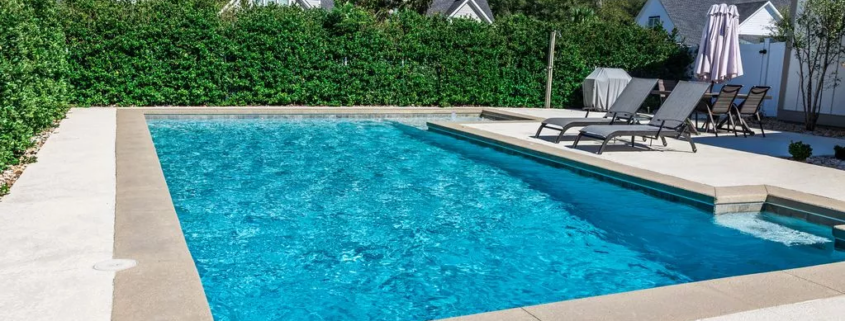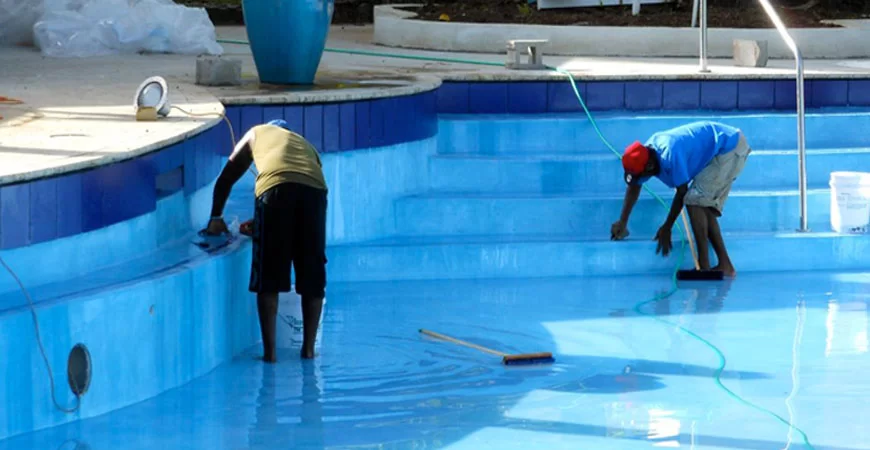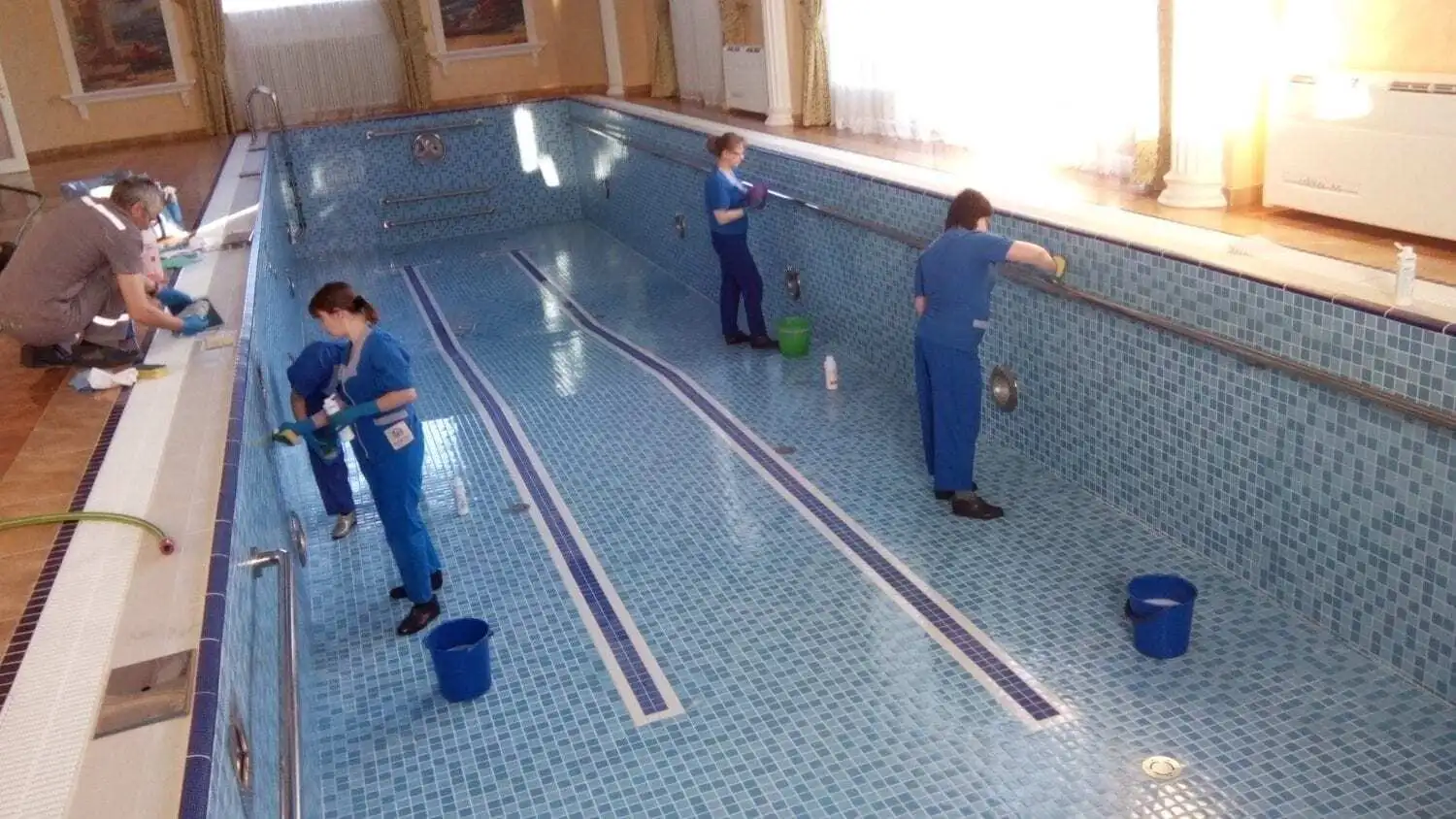When Is The Right Time to Open Your Pool? (2025 – 26 Guide)
Don’t yank the cover off just because the calendar says “spring”. Timing your pool opening is the single easiest way to dodge headaches later. Open too early and you’ll be throwing money at extra chemicals and elbow grease. If you wait too long, you may inherit a green, algae-riddled mess and lose prime swim days.
The smart rule of thumb? Many pool pros advise starting your pool opening process once daily temps stabilize (experts often point to the ~70°F mark). That’s because warmer, consistent weather makes water chemistry simpler and cuts algae risk.
Additionally, you need to make sure to remove and clean the cover, restart circulation, and give the system a solid 24–48 hours to run. Also, you must let chemicals distribute and spot problems before guests arrive.
Do it right and you save time, cash, and precious weekends. But, do it wrong and you’ll be chasing green goo and clogged filters all season. This blog is a perfect guide to find out when to open pool ideally.
Why Timing Matters for Pool Opening
Ask any seasoned pool owner, and they’ll tell you, timing really is everything. Opening your pool a few weeks too late can turn crystal-clear water into a green swamp that eats up your weekends and your wallet. Algae, for example, doesn’t wait politely for summer. Once water temps hover in the 60-70°F range, spores multiply fast, and that once-manageable film on the walls can bloom into a full-blown mess. Pool technicians often note that tackling a bloom mid-season costs hundreds more in chemicals compared to simply opening early and keeping things balanced from day one.
There’s also the equipment factor. Filters, pumps, and heaters have to work harder if they’re fighting debris and algae from the start. And let’s not forget the best perk, extra swim days. A recent consumer survey showed nearly 80% of homeowners wished their swim season lasted longer.
Crack the cover in April instead of May, and that’s a few more weekends of backyard cannonballs, lazy floats, and impromptu pool parties. In other words, the right pool opening schedule isn’t just about avoiding problems but about unlocking more time actually to enjoy your investment.
Factors That Affect the Best Time to Open Your Pool
So, when exactly should you pull that cover off? Truth is, there’s no magic date circled on the calendar for when to open pool. It depends on a mix of weather, what’s been happening under the cover all winter, and even what’s growing in your own backyard.
Weather & Temperature
Think of temperature as the green light. Once daytime highs hover around the mid-60s and don’t dip back into freezing territory overnight, your pool water is primed for chemicals actually to do their job.
Wait until the heat really cranks up, and you’re likely lifting a cover off an algae convention. Jump in too early, though, and you risk wasting chlorine in chilly water that just won’t cooperate. The trick is watching for a string of mild days. Three or four in a row usually means it’s safe to get going.
Pool Cover Condition
Covers tell stories. A taut, clean one probably means you’ve got some wiggle room. A sagging tarp filled with brown water and leaves? That’s trouble brewing. The longer that debris sits, the more it leaches color into your liner and feeds whatever’s lurking below.
Mesh covers let sunlight slip through, which is an open invitation for algae. If yours looks rough, don’t wait; get it off, clean things up, and save yourself from permanent stains or weeks of scrubbing.
Surrounding Environment
Look around your yard. If you’ve got towering oaks or pines, you already know what’s coming (pollen season). Those fine yellow grains might look like dust, but they chew through chlorine and cloud the water faster than you’d think. In places like Georgia or Florida, trees start dumping pollen in March. Leave your pool covered too long, and it’ll collect in a grimy layer that’s way harder to clean later. Opening a little earlier lets you stay ahead of the mess, instead of fighting it all at once.
Common Myths About Pool Opening
Myth-busting time is here! Plenty of pool advice sounds convincing but falls apart in practice. Read these quick debunks so you don’t waste time, money, or elbow grease on bad opening habits.
- “Wait until it’s hot.”
Waiting for a full-on heat wave usually means you’re also waiting for algae to party in your basin.
| Pro Tip |
| Watch for a run of milder days (think consistent mid-60s), not a single warm one-off. Open a little earlier and you’ll avoid a nasty cleanup. |
- “A single shock will fix everything.”
Shock is useful, but it’s not a miracle. If algae or stains are entrenched, you need brushing, filtration work, and multiple chemical treatments. Shock treats chlorine demand; it doesn’t remove stains or fix a clogged cartridge. - “The cover keeps the pool perfectly safe.”
Depends on the cover. Solid covers hold water (and muddy gunk) that can leach tannins. Mesh covers let pollen and light through, which feeds algae. Look at the cover first; it tells you whether to act fast or not. - “Run the pump and the water will balance itself.”
Circulation helps, yes. But it won’t set your pH to 7.4 or bump alkalinity into the right range. You still need test strips or a kit and deliberate balancing. Otherwise: cloudy water, skin irritation, and unhappy equipment. - “Opening later saves money.”
That’s backwards more often than not. A late opening that triggers algae can cost hundreds in chemicals and labor, versus a modest early-season routine that stops problems before they start. - “You can swim right after shocking.”
Don’t. Wait until chlorine drops to safe levels (and follow product labels). Sometimes that’s 24 hours; sometimes longer. Rushing back in is an invitation to stinging eyes and chemical burns. - “One skim and you’re done.”
Expect repeated skimming, brushing, and filter checks during the first week. Old debris, pollen, and leaves don’t vanish with one pass. - “Home remedies are fine.”
Cute stories. Bad science. Stick to proven pool chemicals and procedures. Homemade mixes can change pH unpredictably or damage surfaces.
Wondering when is the right time to open your pool?
Step-by-Step Pool Opening Checklist (2025-26 Update)
The short version is to do each step in order and skip none. Small mistakes now mean big headaches later. This pool opening checklist is tight, practical, and written for real pool lovers.
● Remove and clean the pool cover
Start slow. Peel one edge, fold, repeat. Don’t dump all that muck into the pool. Bail standing water first (a simple bucket works). Hose both sides down, scrub stubborn spots, then let it dry completely before storing. Damp folds = mildew. If the cover’s a soggy mess, expect extra scrubbing after you open.
● Skim debris, vacuum floor, brush walls
Skim first, vacuum second, and brush last. You want the filter to handle fines, not a debris avalanche. Pay special attention to steps and corners. Algae loves those spots. If robot vacs are your thing, run it once, then hand-vac for stubborn bits.
● Inspect pump, filter, and skimmer basket
Power off. Touch nothing electrical while things are live. Open baskets, dump debris, check seals and hoses for cracks. Smell the motor area. That’s because a burnt scent means trouble. Backwash sand/DE systems or rinse cartridges before you run long cycles. Tiny replacements now beat a full motor swap later.
● Test water chemistry (pH, alkalinity, chlorine)
Test first. Always. Aim for pH ~7.2–7.6; alkalinity roughly 80–120 ppm; free chlorine about 1–3 ppm (higher if you’re shocking). Use a decent liquid kit or a digital reader because cheap strips are hit-or-miss. Adjust alkalinity before pH. Make incremental changes and re-test between each tweak.
● Shock the pool & balance chemicals
Shock distributes better when the pump is on. Scatter the shock around the pool; don’t dump it in one spot. Wait, circulate, then re-test. Don’t forget calcium hardness and stabilizer (cyanuric acid). Overdo the chemicals and you’ll spend days chasing balance. Undervdo and algae will laugh at you.
● Run the circulation system for 24–48 hours
Run it long and steady. At least 24 hours; 48 if the water was dirty. This evens out chemicals and gives filters a chance to pull fines. Watch pressure gauges and listen for odd noises. Variable-speed pumps? Run them long at lower RPMs if possible.
● First-week followups (don’t skip these)
Check chemistry daily for the first week. Skim every day. Backwash or rinse the filter after heavy loads. Expect one or two small chemical tweaks. If the water doesn’t clear after 48 hours, stop, test again, and troubleshoot. Don’t keep dumping shock blindly.
Regional Differences: When Should You Open in Your State?
Your region’s climate (winter severity, frost risk, typical spring warming) heavily influences the best time to open pool. These aren’t just generalizations. Use them as guidelines and watch your local weather + water temps to decide.
Northeast & Midwest: Late April → Early May
- In many Northeastern states (Pennsylvania, New York, Maine) and the Midwest (Michigan, Ohio, Wisconsin), the ground thaws by mid-April, but water temps often lag. Pool owners commonly wait until late April or even early May for steady daytime highs near 65-70°F
- Public/open pools in Illinois often schedule openings around Memorial Day weekend (late May) because even if the cover is off earlier, usage is low until the water feels comfortable.
South & Southeast: Late March → Early April
- States like Georgia, Alabama, Florida, and Texas often see milder winters. Rains and milder nights make late March or early April a solid window to open pools for most homeowners.
- Example: in southern Georgia/Florida, many open in April because water temps trend upward quickly once nights stay in the 50s-60s°F. If you have a heater, you might even crack open earlier for maintenance tasks.
- Be cautious of storm season, though: early spring in the Southeast can bring sudden heavy rain, which dilutes stabilizer, overfills pools, or washes in debris. So even if the air temperature is good, check for impending downpours.
West Coast & Southwest: Year-Round with Seasonal Maintenance
- In places like southern California, Arizona, parts of Nevada, and coastal Oregon/Washington, winters are so mild that many swimming pool designs never fully close, or open very early. Maintenance becomes seasonal rather than strictly “opening season.”
- Still, even there, timing of heavy maintenance or full chemical shock treatments tends to be scheduled for early spring (March-April), before the heat ramps up and algae and bacterial growth accelerate. Running the pump and filtration during mild months avoids big surprises when the sun hits.
- Regions with high sunshine and warm winters must still watch for cooler nights, sudden storms, or cold pool shade areas. Surface temps might lag behind air temp, so always test before letting swimmers in.
DIY vs Professional Pool Opening
Here’s a clear side-by-side view. It is short, specific, and practical. So, you can decide if DIY pool opening or hiring a pro fits your needs best.
| Option | Pros | Cons |
| DIY Pool Opening | ● Saves $200–$400 on average.
● You pick the timing. No waiting on schedules ● Control over chemicals and methods |
● Easy to misbalance water chemistry
● Small equipment issues often overlooked ● Takes several hours of hands-on work |
| Professional Opening | ● Technicians spot hidden problems early
● Usually done in one visit ● Warranty protection with many services |
● Costs $250–$500 depending on region
● Must book early in peak months ● Less control over timing and approach |
How much does a 40×60 Morton building cost?
How to Keep Your Pool Swim-Ready All Season
A pool looks peaceful from the pool deck but has chemistry swings, dust, pollen, and constant motion underneath. You don’t need perfection. You need a habit. Small checks, done often, stop small problems from turning huge.
Weekly Testing & Balancing
Treat this like checking a tire pressure gauge (quick, regular, decisive).
- When: Once a week minimum. Better: twice if the sun’s brutal or after heavy storms.
- What to check: pH 2–7.6, total alkalinity 80–120 ppm, free chlorine roughly 1–3 ppm. Write the numbers down. Seriously. A notebook or phone note shows trends.
- When to test during the day: Morning or evening, not noon. Intense sun can hide real chlorine loss.
- Tools that matter: A liquid test kit or a digital reader. Strip tests are okay for a quick glance, but don’t rely on them for exact fixes.
- How to adjust: Fix alkalinity first, then pH. Add small doses, wait, and re-test. Repeat if needed.
- Why it helps: Steady chemistry protects skin, hair, and equipment. Plus, it saves money on wasted chemicals.
Backwashing & Filter Care
Filters don’t complain loudly. They just slow down!
- If pressure climbs 8–10 psi over the clean reading, backwash or rinse.
- Cartridges need a hose shower every few weeks. Once a summer, soak them overnight.
- Skimmer baskets clog faster than you think, especially after storms. Empty them often, or you’ll smell it before you see it.
Brushing & Skimming
Leaves on Monday, pollen on Tuesday, dragonflies on Wednesday is the routine elements for a residential pool. Skim them before they sink!
- Two minutes with a net every day beats an hour vacuuming later.
- Brush walls and steps twice a week. Don’t just swipe lazily. Remember that algae hides in corners.
- If you hear a gritty sound under the brush, that’s scale starting to form. Catch it early.
Mid-Season Shock
No matter how careful you are, the water gets “tired.” Sunscreen, sweat, barbecue ash, it all ends up in there.
- Shock every 2–3 weeks, more if you throw pool parties.
Non-chlorine shock = quick recovery
Chlorine shock = heavy clean
- Run the pump overnight. Re-test before anyone dives in. If you can still smell chlorine strongly, wait.
Why Choose Professional Pool Opening Services?
When pools open, hidden risks show up: algae, mis-dosed chemicals, cracked plumbing. Pros see those things early. Here’s why hiring someone who knows the trade often saves more than it costs.
● Avoid costly mistakes with chemical dosing.
Professionals know how to mix shock, chlorine, stabilizer, alkalinity, and calcium hardness without overshooting. Mistakes in chemical balance are among the top causes of irritated swimmers, damaged liners, and expensive waste.
● Detect small problems early.
Cracks in pool shells, leaky plumbing, and worn pump seals start tiny. A small crack or worn O-ring left alone can turn into a repair that costs thousands. Professionals inspecting the shell, surfaces, and equipment can catch issues before they spread.
● Get a “ready-to-swim” pool in less time.
Think of pros as finishing a puzzle you already started. They bring test kits, high-powered vacuums, tools, and techniques that speed up cover removal, debris cleanup, and water balancing. What takes a weekend for many DIYers can often be done in a day by a team.
Things to watch out for if you go pro:
- Cost is higher than DIY. But compare that to the price of liner damage or pump replacement, and it often still looks reasonable.
- During spring, pool companies have a backlog. Booking early helps.
Need help opening your pool this season? Our experts offer professional pool maintenance and pool opening service that’s fast, dependable, and hassle-free. Contact us today to schedule your opening and swim sooner (without the stress).
How much does a 40×60 Morton building cost?
Frequently Asked Questions (FAQs)
What temperature should it be before opening my pool?
Aim for steady warmth, not a single warm afternoon. When daytime highs stay around sixty to sixty-five degrees Fahrenheit for several days and nights, no longer dip near freezing, chemicals behave predictably, and algae is less aggressive. Open them, and you’ll spend less time scrubbing. If nights still bite, wait a little because pipes and seals prefer gentler starts.
What chemicals do I need to open a pool?
You’ll want baseline supplies: a sanitizer like chlorine or a salt system plan, a shock product, pH adjusters, an alkalinity increaser, and a stabilizer if your region calls for it. Also, check calcium hardness. Test first, add second, and do it slowly. Overdoing anything is how liners fade and pumps suffer, so measure, wait, re-test, repeat.
Can I open my pool too early?
Yes, you can, though early opening usually causes extra legwork rather than catastrophe. Cold nights can make chemicals sluggish and can stress equipment if the water gets near freezing. But opening a bit early to remove debris and inspect gear often prevents larger problems later. The real danger is opening too late, when algae and staining have already taken hold.
How long after shocking can you swim?
Don’t guess. Test. Most pools fall to safe chlorine levels within about 24 hours with good circulation. Aim for free chlorine around 1 to 3 parts per million. If a strong chemical smell lingers, wait and retest before diving in.
How much does professional pool opening cost?
Ranges vary by region and pool size. Expect basic openings in the low hundreds. Full services with filter cleaning and inspections push the price higher. Get itemized quotes. Labour, chemicals, and extras add up but often prevent expensive repairs.
Conclusion
There isn’t one single date circled in red for opening your pool. The best moment depends on your local temperatures, your yard’s quirks, and how much maintenance you want on your plate later. What surprises most people is that opening a little earlier often saves money. Cool water keeps algae in check, chemicals last longer, and you don’t spend the first hot weekend of the season scrubbing instead of swimming. Think of it as giving yourself a head start, not extra work.
So, why wait? Ready to dive in? Book your professional pool opening service today and enjoy a clear, swim-ready pool from the very first warm weekend.





